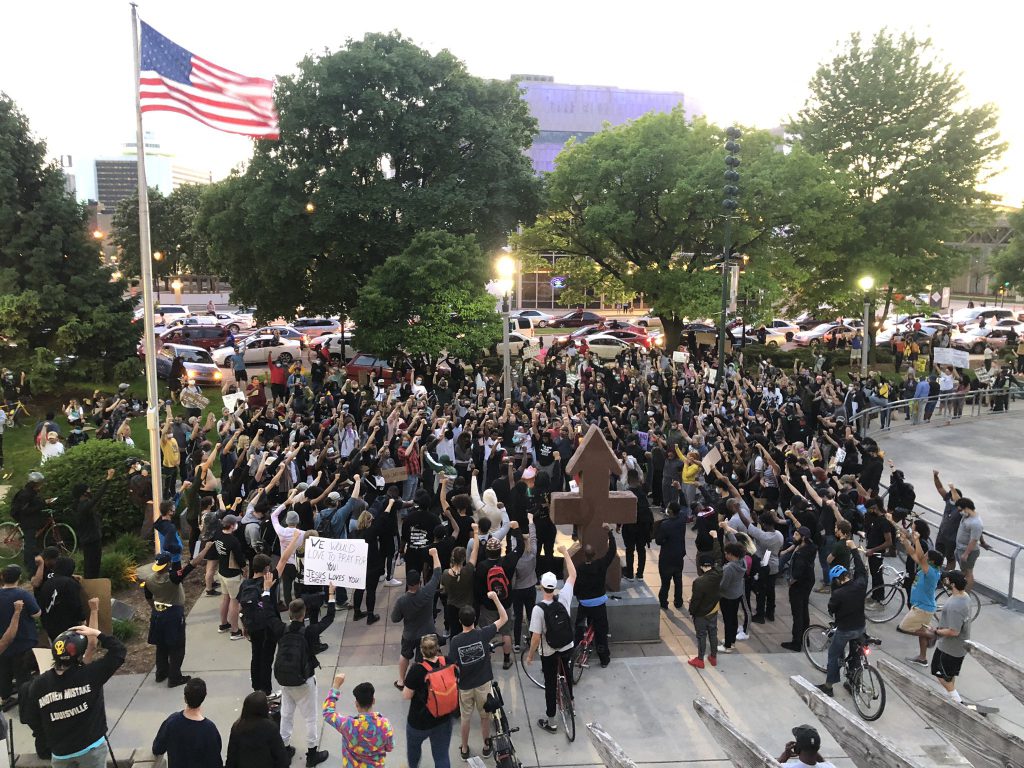Better Than Breier Isn’t Good Enough
Milwaukee Police aren’t using bullets and billy clubs on protesters. But that’a low bar by which to measure improvement.

Protesters rally at Red Arrow Park on June 1st, 2020, where Dontre Hamilton was killed by a Milwaukee Police officer.
Was the Jim Crow era acceptable because it was not slavery?
That’s the logic used by Milwaukee Police Department‘s Assistant Chief, Michael Brunson when he claimed that MPD’s use of rubber bullets and tear gas is just fine because it isn’t as bad as the MPD in the 1960’s and the use of “a handgun and a billy club.”
Brunson was referencing the Chief Harold Breier era when Milwaukee cops treated black citizens as hostile invaders.
In 1967 when Father James Groppi and the NAACP Youth Council led marches for 200 straight days protesting housing segregation and other discrimination, Breier’s force routinely harassed Youth Council members and jailed them for minor offenses like littering or jaywalking. When marchers were pelted with bottles and rocks, the MPD did nothing to protect them. He even ordered his cops at the marches to hide their badges so they couldn’t be identified when brutalizing protesters.
There were calls for police reform then such as foot patrols so officers would get to know people in the community and for cops to work with citizens block-watch groups to reduce crime. But Breier resisted any change. He trashed efforts to integrate Milwaukee Public Schools, calling them, “bussing crime all over the city.” Recently deceased Milwaukee Journal Sentinel columnist Eugene Kane called Breier, “a racist administrator, a borderline fascist, and the man who contributed to the segregated reputation of Milwaukee more than any other.”
Worst of all, Breier’s officers routinely got away with murdering Milwaukee’s black citizens:
- 1972 19-year-old Jacqueline Ford: shot and killed in her own home by a white detective who claimed his gun fired when he slipped on the steps of her upper flat apartment.
- 1974: Jerry Brookshire: killed by a Milwaukee cop who claimed his gun fired — by accident — as he fell. When eyewitness Ola Mae Davis reported that Brookshire was unarmed and shot while climbing a fence, first her home was firebombed, then the motel she had to move to was burned down.
- 1974: Breier’s finest raided an apartment building allegedly looking for a murder suspect. In the process, they shot and murdered Johnnie Starks and killed Mary Pendleton in a fire started by their tear gas, neither ever charged with a crime.
- 1975-1979: A U.S. Department of Justice investigation found that 22 people died in MPD custody during this time.
None of these cops was disciplined or convicted.
By 1981 the community had enough, and its protests resulted in some change. Ernest Lacy, picked up by police as a suspect for a rape he didn’t commit, was held by police with his face in a gutter and a knee on his back. He was never offered first aid and shortly thereafter died in police custody. One officer was eventually fired, four suspended, none convicted.
The Lacy murder sparked marches and a large protest movement that led to Wisconsin’s legislature eliminating lifetime appointments for police chiefs, leading to Breier’s retirement.
Rather than defend the status quo by claiming to be less evil than the worst in our history, Brunson and his boss, Chief Alfonso Morales, should listen and act on the demands of the community as articulated by protesters.
They should ban the use of choke holds, create a publicly accessible database of excessive-force encounters, end their quest for and use of military equipment, require officers to de-escalate situations, prohibit the use of deadly force until they’ve exhausted all other reasonable means. The legislature should once again mandate that Milwaukee police live and pay taxes in the community they serve.
Finally, Mayor Tom Barrett and the Common Council must redirect millions of dollars from the police budget to community-based organizations and mental-health intervenors. We need to reverse the shredding of social safety nets that has left police having to deal with social and mental health problems they’re not trained for.
These actions would surely lead to safer neighborhoods. Perhaps they might also result in Brunson and Morales getting the message that Milwaukee citizens deserve a police department that works with, not against, the community, rather than one slightly better than Harold Breier’s.
Dr. Michael Rosen (Economics) and Charlie Dee (American Studies) are retired professors from Milwaukee Area Technical College and leaders of American Federation of Teachers Local 212
More about the 2020 Racial Justice Protests
- Plea Agreement Reached On Long-Pending Sherman Park Unrest Charges Involving Vaun Mayes - Jeramey Jannene - Oct 17th, 2024
- Rep. Ryan Clancy Settles With City Following 2020 Curfew Arrest - Jeramey Jannene - Dec 12th, 2023
- Supervisor Clancy Applauds Settlement in Clancy vs. City of Milwaukee - State Rep. Ryan Clancy - Dec 12th, 2023
- Tosa Protest Assails Federal Court Decision Exonerating Police - Isiah Holmes - May 9th, 2023
- Wauwatosa ‘Target List’ Trial Begins - Isiah Holmes - May 3rd, 2023
- Shorewood Spitter Found Guilty For 2020 Protest Confrontation - Jeramey Jannene - Apr 20th, 2023
- City Hall: City Will Pay 2020 George Floyd Protester $270,000 - Jeramey Jannene - Feb 14th, 2023
- Tosa Protest Tickets Dismissed - Isiah Holmes - Jul 21st, 2022
- Op Ed: ‘We Need More’ - Charles Q. Sullivan - Mar 4th, 2022
- Milwaukee Officers Circulate “2020 Riot” Coins? - Isiah Holmes - Nov 14th, 2021
Read more about 2020 Racial Justice Protests here
Op-Ed
-
Unlocking Milwaukee’s Potential Through Smart Zoning Reform
 Jul 5th, 2024 by Ariam Kesete
Jul 5th, 2024 by Ariam Kesete
-
We Energies’ Natural Gas Plans Are A Mistake
 Jun 28th, 2024 by John Imes
Jun 28th, 2024 by John Imes
-
Milwaukee Needs New Kind of School Board
 Jun 26th, 2024 by Jordan Morales
Jun 26th, 2024 by Jordan Morales



















A very good op-ed! The Common Council and MPD should read it carefully and act!
Michael Rosen and Charlie Dee make excellent points in their “Better Than Brier Isn’t Good Enough.” We should look for a new Chief of Police as articulate as Ed Flynn and as thoughtful as former Sheriff Richard Artison.